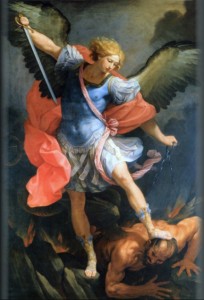 Seventh Day Adventists and Jehovah’s Witnesses share the view that Jesus and the Archangel Michael are one and the same:
Seventh Day Adventists and Jehovah’s Witnesses share the view that Jesus and the Archangel Michael are one and the same:
Michaeal Heb.Mika’el, literally, “who [is] like God?” He is here described as “one of the chief princes [Heb. śarim].” Later He is described as Israel’s particular protector (Dan. 12:1). His identity is not definitely stated here, but a comparison with other scriptures identifies Him as Christ. Jude 9 terms Him “the archangel.” According to 1 Thess. 4:16, the “voice of the archangel” is associated with the resurrection of the saints at the coming of Jesus. Christ declared that the dead will come forth from their graves when they hear the voice of the Son of man (John 5:28). It thus seems clear that Michael is none other than the Lord Jesus Himself .
Francis D. Nichol, The Seventh-day Adventist Bible Commentary, Volume 4 (Review and Herald Publishing Association, 1978; 2002), 860.
At times, individuals are known by more than one name. For example, the patriarch Jacob is also known as Israel, and the apostle Peter, as Simon. (Genesis 49:1, 2; Matthew 10:2) Likewise, the Bible indicates that Michael is another name for Jesus Christ, before and after his life on earth.“Who is Michael the Archangel?” http://www.watchtower.org/e/bh/appendix_11.htm (accessed 4/19/2011).
Yet one wonders, how they can hold such a view in light of the scriptures. For example, in the book of Jude, an argument is made against false teachers and apostates who have infected the church. Jude makes an argument that they blaspheme “glorious ones” or beings of higher status themselves. To drive the point home he argues that Michael did not dare pass judgment on Satan:
Yet in like manner these people also, relying on their dreams, defile the flesh, reject authority, and blaspheme the glorious ones. But when the archangel Michael, contending with the devil, was disputing about the body of Moses, he did not presume to pronounce a blasphemous judgment, but said, “The Lord rebuke you.”(Jud 8-9)
If Michael is actually Jesus Christ the eternal glorious second person of the trinity upon whom all fullness of God dwells (Col. 1:19), then how could it possibly be so that he lacked authority to judge the devil? It is logically incoherent! This argument only makes sense in light of the orthodox position that Satan is a rebel archangel himself giving him equal status to Michael. Adventist and Watchtower theology has demoted Christ. It is heresy.
Jesus had no qualms against rebuking and judging the devil,
You are of your father the devil, and your will is to do your father’s desires. He was a murderer from the beginning, and has nothing to do with the truth, because there is no truth in him. When he lies, he speaks out of his own character, for he is a liar and the father of lies.(Jn 8:44)
Michael is an angel. Angels are created beings. That they were created is clearly implied in Psalm 148:2, 5: “Praise him, all his angels, praise him, all his heavenly hosts.… Let them praise the name of the Lord, for he commanded and they were created.” They were in fact created by Christ,
For by him all things were created, in heaven and on earth, visible and invisible, whether thrones or dominions or rulers or authorities—all things were created through him and for him.(Col 1:16)
Jesus is not Michael. The Adventists and Jehovah’s Witnesses are preaching a different Jesus.




